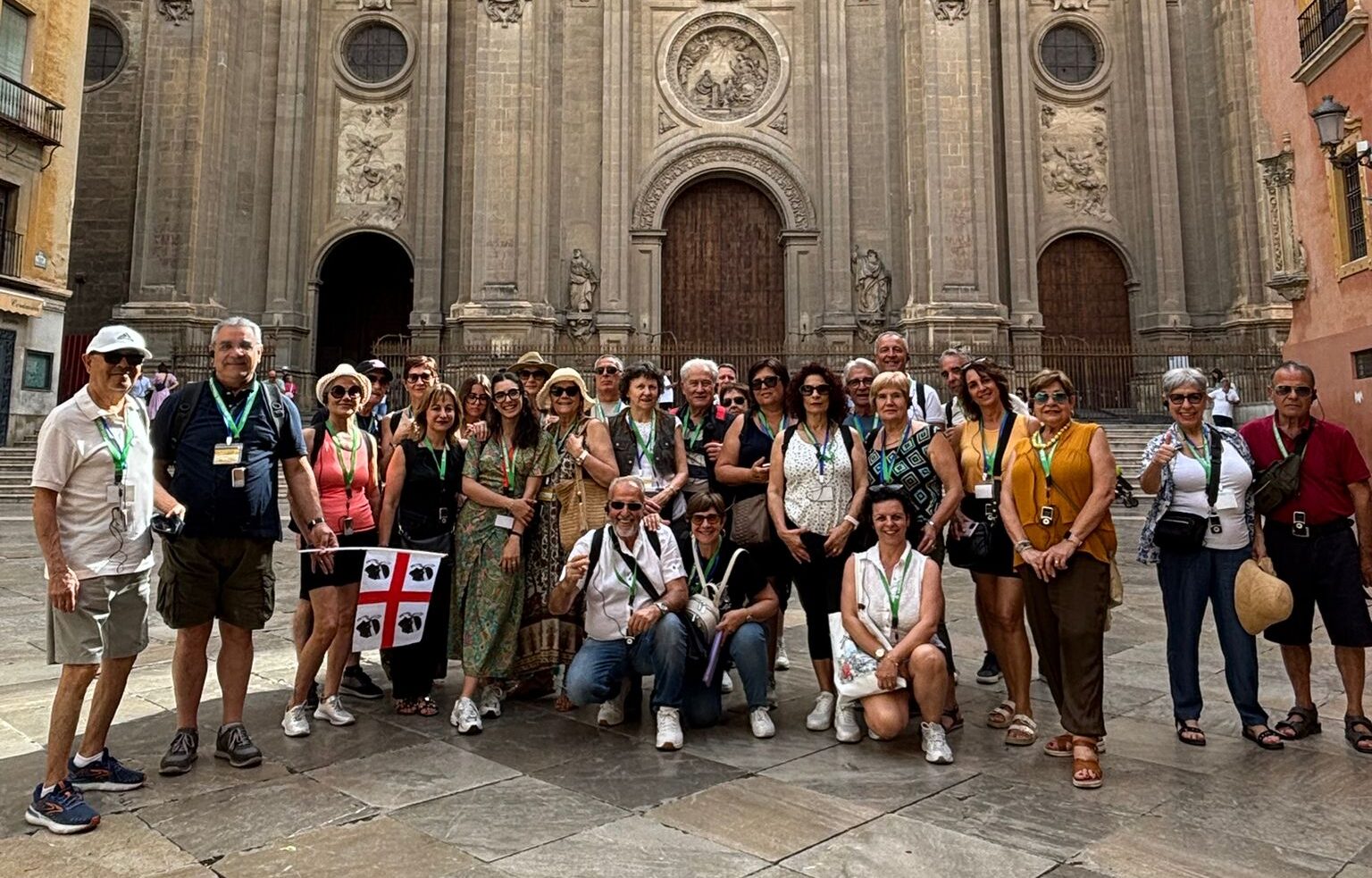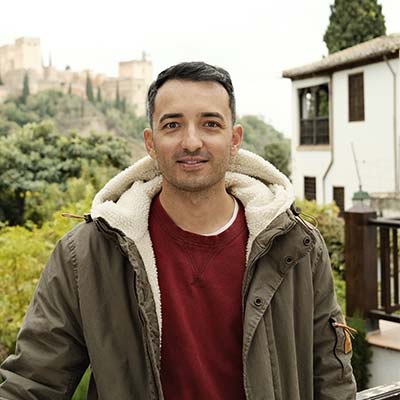The historic center of Granada, known as Granada Old Town, Spain, is home to remarkable heritage sites you shouldn’t miss. Discover everything worth seeing in this storied neighborhood and get ready to enjoy its rich history and vibrant atmosphere. For more details, you can explore different private tour options around the city on our website by clicking here.
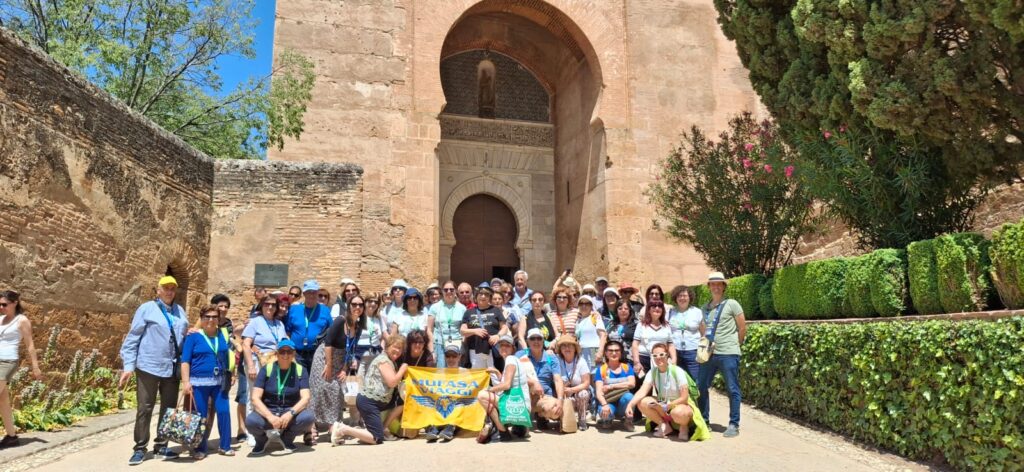
Table of Contents
Granada Cathedral
Granada Cathedral is one of the most important symbols of the Renaissance in Granada along with the Charles V Palace and the main Altar of Saint Jerome. You can visit the monument on our Private tour to the interior of the Cathedral and Royal Chapel.
Inside the Granada Cathedral
The initial design followed a conventionally Gothic style. But once Diego de Siloé took over as lead architect, he completely transformed the project’s style.
In the 16th century, it was already considered an eighth wonder of the world. Holy Roman Emperor Charles V initially chose the site as his burial ground. Its beauty and magnitude make it a must-see for anyone visiting the city.
The beginnings of the building of the Cathedral date back to 1506: architect Enrique de Egas conceived the first project for the Cathedral in 1506. He already planned to incorporate the Royal Chapel as an annex. Queen Isabella’s death in 1504 meant the Royal Chapel had to be built first. They didn’t set the first stone of the cathedral until 25 March 1523.
Just three years later, the arrival of Holy Roman Emperor Charles V brought about a change in the building plans, since the Emperor wanted the Cathedral to be his burial site. Despite this being postponed, the Emperor dismissed the original architect and appointed Diego de Siloé as master builder.
Alhambra
The Alhambra, situated in the heart of Granada Old Town, Spain, stands as one of the nation’s most iconic and treasured historical landmarks. UNESCO declared this majestic palace complex a World Heritage Site. It blends the elegance of Islamic art with the strength of a medieval fortress.
Highlights include the Nasrid Palaces, famous for intricate designs and the Court of the Lions. The Generalife Gardens offer fountains and stunning views. The Alcazaba fortress provides panoramic views of the city.
We offer you an unforgettable experience of history, art, and architecture with our Alhambra Private Tour with Nasrid Palaces and Generalife Gardens. For more details, click the link.
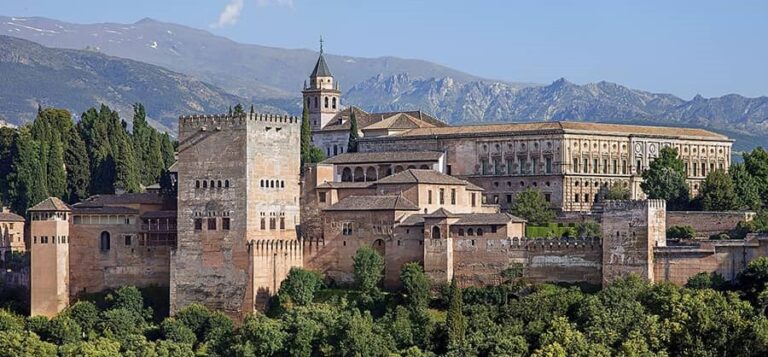
Alcaicería
Granada Old Town, Spain: Alcaicería comes from the Arabic al-Kaysariyya and refers to the payment of duties to Caesar for the trade and custody of valuable goods. Although many alcaicerías existed in Islamic Spain, only Granada’s survived — even after a devastating fire in 1843, when the authorities rebuilt it.
The Nasrids established it during their period of rule as the center of the silk trade, which was Granada’s most important industry at the time. Furthermore, it was located in the heart of the Islamic medina near the Aljama Mosque, it resembled a traditional souk filled with shops and narrow streets.
Today’s Alcaicería reflects a 19th-century Neo-Arabic rebuild. It offers a glimpse into Moorish Granada while functioning as a modern marketplace. Moreover, its role as a commercial and handicraft souk breathes life into the space. It’s now a starting point for new bazaars featuring jewellery, bronze, marquetry, and ceramics.
The Madrasa of Granada
Sultan Yusuf I founded it in 1349. The Madrasa of Granada was the only Islamic university in al-Andalus. It offered studies in law, theology, medicine, and science, reflecting the intellectual peak of the Nasrid period.
After the Christian conquest, rulers repurposed it and later remodeled it in Baroque style. However, parts of the original structure — such as the mihrab — still remain.
Today, it belongs to the University of Granada and hosts cultural and academic events. Therefore, it stands as a symbol of the city´s blended Islamic and Christian heritage.
Royal Chapel
The Royal Chapel represents the transition from the Medieval to the Modern period, just as the Catholic Monarchs symbolize the transformation of Spain. You can visit the monument on our Private Tour of the Albaicín and Royal Chapel.
Enrique Egas began planning the Royal Chapel in 1506, after its founding in 1504. He created an extremely austere building and intended it to physically and aesthetically integrate with the future Cathedral. It was completed in 1517.
Domenico Fancelli sculpted the tomb of the Catholic Monarchs, which stands out as a unique piece of Spanish Renaissance funerary sculpture. Ferdinand appears as a soldier, while Isabella wears courtly attire. Additionally, Bartolomé Ordóñez sculpted the tombs of Philip the Handsome and Joanna the Mad with more expressive detail.
Main Grille of the Royal Chapel
Bartolomé de Jaén designed the Main Grille and embossed it richly with the Monarchs’ coat of arms and scenes from the Passion of Christ. Furthermore, the interior walls are adorned with a wide frieze referencing the Conquest of Granada, the death of the Monarchs, and the completion of the chapel.
Plaza Bib Rambla
Plaza Bib-Rambla has traditionally served as the main square in Granada’s Old Town, Spain. It’s the closest Granada has to a typical Spanish and Andalusian plaza mayor, though it lacks a colonnade and public buildings.
Its origins date back to the Nasrid period, when it was an open space linked to the main city gate: Bab al-Ramla or the Sand Gate.
Due to its excellent location and potential for expansion, city authorities reformed the square shortly after the surrender of the city around 1495. In 1505, King Ferdinand the Catholic ceded it to the city as a place for walking and trade. Between 1516 and 1519, the square began to expand in a more orderly way.
Bib Rambla Square as a Public Celebration Area
In the 16th century, it became Granada’s main celebration area: equestrian games, Corpus Christi processions, royal proclamations, and street vendors. By the 18th century, the square held 54 fruit and vegetable stalls. In 1880, a garden and a monument to Fray Luis were added, along with lime trees.
Today, Bib Rambla continues to host local festivities, such as the Carocas and Tarasca procession during Corpus Christi. In fact, it remains one of the liveliest squares in the city throughout the year.
Giants Fountain in Bib Rambla Square
The most impressive fountain in Granada stands at the center of Bib Rambla. Interestingly, it was originally not intended for public use, it was made for the cloister of the now-vanished Convent of the Agustinos Calzados.
The first circular bowl rests on the necks of four anthropomorphic beings. These nude “Gigantones” (giants) give the fountain its popular name. They support the white marble sculpture of Neptune, who holds his trident in one hand and raises the other in greeting.
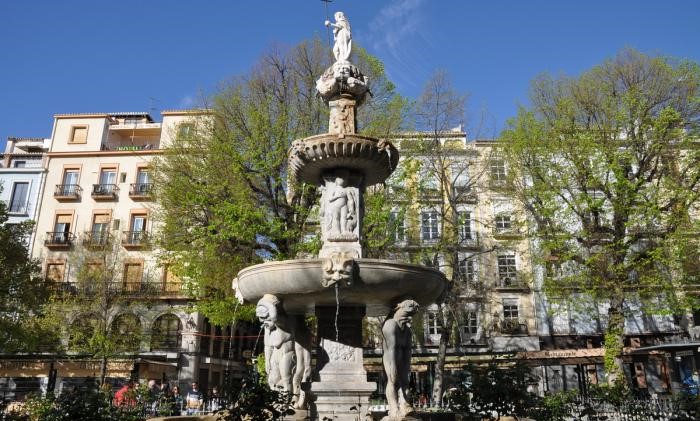
Giants Fountain in Bib Rambla Square
Plaza Nueva
The public square, now known as Plaza Nueva, is the result of a long evolution from the early 16th century to the mid-20th century. Builders covered the Darro River, which now flows hidden beneath the square.
After the Conquest, Granada lacked open spaces for social life. City Hall created Plaza Nueva as the first major development to reflect the city’s new Spanish identity.
Located in Granada Old Town, Spain, Plaza Nueva connects the three key areas of Nasrid Granada: the Medina, the Alcazaba Qadima in the Albayzín, and the Alhambra via the Gomérez Slope.
The square has hosted diverse civic activities: jousting, tournaments, cane and bull games, public executions, royal proclamations, and military celebrations. Later, the city expanded it to create a fitting urban framework for the Royal High Court.
If you’re interested in visiting this place, our Private Tour of the Albaicín offers a great experience.
Church of Saint Ana
The Church of Saint Ana, built between 1537 and 1540 on the ancient Zirid mosque Aljama of Almanzora, features a brick façade, a notable portal, and a bell tower decorated with blue and white ceramic tiles. Its interior has a single nave with side chapels and a wide apse.
Notable artworks include a 16th Century Calvary by Diego de Aranda, the Virgen de la Esperanza by José Risueño, and in the major chapel, carvings of Saint Jerome and Saint Juan de Dios, plus a canvas of the Birth of the Virgin.
City Hall and Plaza del Carmen
Granada City Hall’s current building, located in Plaza del Carmen, began as the home of the male Carmelites convent. Only the larger “new cloister” remains. It now holds City Hall’s courtyard.
In 1848, the Carmelites ceded the convent to the Municipal Government. In the early 20th century, architect Modesto Cendoya remodeled the façade and built the stairway.
Atop the façade is a statue by Guillermo Pérez Villalta: a horse in motion with a blindfolded nude rider holding a golden sphere. It symbolizes a fleeting moment of triumph and balance.
Plaza del Carmen offers picturesque views of historic buildings and provides a perfect setting for visitors to enjoy. You can visit this square in our Granada Private Tours, being the starting point of some of them. For more information, click here!
Granada Old Town, Spain, is a unique blend of history, culture, and art, where every corner reflects its rich past. Exploring its monuments, lively plazas, and remarkable landmarks offers visitors a memorable journey through time. Whether you stroll its ancient streets or join a private tour, Granada’s atmosphere will leave a lasting impression.

